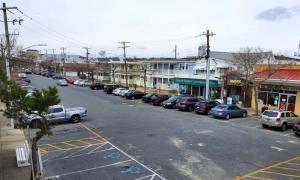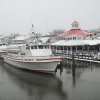Bike lanes not likely on Baltimore, Wilmington in Rehoboth
A Rehoboth Beach consultant hired to assist the city through streetscape improvements to Baltimore and Wilmington avenues unveiled a number of possibilities during a meeting May 26. No decisions were made, but it appears the creation of a bike-specific travel lane on those two commercial district streets will not be a part of the upgrades.
The Wilmington/Baltimore Avenue Streetscape Task Force was created by city commissioners to improve commercial viability and access for pedestrians and bicycles. The area of interest includes the first two blocks of Baltimore and Wilmington avenues, First Street between Baltimore and Wilmington avenues, and Second Street between Wilmington and Rehoboth avenues.
The group began meeting in late March, conducting three meetings before making a list of recommendations to the commissioners – continuing to investigate the most practical way to bury utilities to the fullest extent possible; proceeding with the design without a traffic study; not including one-way streets; and not pursuing low vehicle-access zones, except possibly at the end of the avenues near the Boardwalk. During a meeting April 16, Rehoboth Beach commissioners unanimously supported the recommendations.
The city has hired the Rossi Group, based in Hunt Valley, Md., to help guide the city through the process to the point of construction. Alexis Morris, a senior planner for the company, made the recent presentation, which included three options, one of which included a five-foot-wide bike path on both sides of both streets.
Frank Cooper, on the task force as a citizen, said vehicular traffic on those two streets is already slow and bikes already go with the flow of traffic.
Joe Baker, a Wilmington Street restaurant owner, agreed, instead suggesting that more bike racks are needed. Bikers are being encouraged to come into Rehoboth, but then people have to lock their bikes on signs or poles, he said.
Jenny Burton, a Baltimore Avenue business owner, also agreed, describing the bike lane as a waste, she said. Bikes and scooters pretty much go with the flow of traffic already, she said.
Despite future implementation challenges, task force members continue to be more interested in Morris’ concepts for burying utilities. She provided the group with a general plan for accomplishing that goal, but said it would be difficult, because, unlike Rehoboth Avenue, there’s not a median going down the middle of the road to hide the required transformers.
Morris said there are a number of things to consider with underground utilities – the state’s transportation department will not pay for it, but design can be done at the same time as streetscape design and then constructed before streetscape construction.
Morris said there are 44 existing utility poles on Baltimore and Wilmington avenues. She said the estimated number of transformers needed would be 19. She also said undergrounding utilities on First and Second streets is not likely because of space constraints.
Morris said the preference would be pad-mounted transformers on private property, next to the city’s right-of-way, with protection needed for transformers within 10 feet of the roadway.
Howard Menaker, another citizen member, said he was encouraged by how few transformers would be needed to accommodate the power needs on the two streets.
Alex Moore, a Wilmington Avenue hotel owner, asked if bumpouts had been considered for the transformers on the ground. He said it will be difficult to put them in front of already existing buildings.
“The city would lose parking, but there’s an opportunity to improve also esthetic value,” said Moore, adding that bumpouts could also be a place where 5G or 6G poles are installed in the future.
After giving her presentation, Morris tasked the group with a Friday, June 11 deadline for making a decision on narrowing down what the group would like to see for final design. She said the options can be mixed and matched.
The goal is for continuity between the different sections of the interest area, said Morris. The city doesn’t want to set expectations at one end and then change them, she said. The task force is scheduled to next meet at 9 a.m., Wednesday, June 2, to discuss in detail the street design proposals. If needed to make recommendations, Mills said he’s blocked off another meeting for the same time Wednesday, June 9.
Chris Flood has been working for the Cape Gazette since early 2014. He currently covers Rehoboth Beach and Henlopen Acres, but has also covered Dewey Beach and the state government. He covers environmental stories, business stories and random stories on subjects he finds interesting, and he also writes a column called Choppin’ Wood that runs every other week. He’s a graduate of the University of Maine and the Landing School of Boat Building & Design.


























































